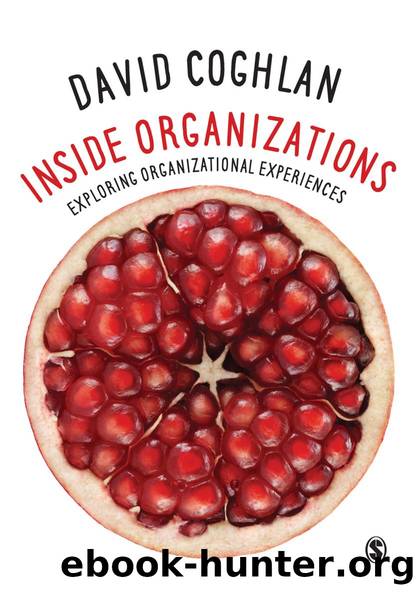Inside Organizations by David Coghlan

Author:David Coghlan [Coghlan, David]
Language: eng
Format: epub
Tags: Reference, Research, Social Science, Business & Economics, Management
ISBN: 9781473987500
Google: 1iPRDAAAQBAJ
Publisher: SAGE
Published: 2016-08-08T04:15:22+00:00
Theory of Action
In Chapter 1 the notion of a theory of action was introduced. What a theory of action emphasizes is how organizations have a theory-in-use; that is, the theory that is actually employed, usually tacitly, and is unrecognized by the people employing it. Argyris found that most organizational theory-in-use is grounded in an implicit disposition to controlling, winning and to avoiding embarrassment. The assumptions are: be in unilateral control, win and do not lose, suppress negative feelings and behave rationally. The action strategies that follow such assumptions are aimed to protect and defend the self against embarrassing situations by speaking in inferred and attributed categories thereby engaging in a defensive reasoning mindset to explain actions and to implement future actions. The consequences are routines that promote protectiveness, self-reinforcing behaviour, escalating error and ultimately increased defensiveness and decreased effectiveness. But because these routines are unquestioned the decreased effectiveness may not be noticed. Have you noticed situations backstage where your colleagues discuss a current problematic issue and make comments in the vein of âof course the boss doesnât want to knowâ?
As Argyris explains defensive routines are thoughts and actions that are used to protect individuals, teams and organizations from dealing with reality. They are reinforced by organizational members who would prefer if these routines didnât exist but defend them as being necessary and part of being in the âreal worldâ. The routines are based on untested inferences that organizational members make. Organizational members reach conclusions that they believe they have tested carefully, but they havenât because they have been framed to make them untestable because they are privately held. In terms of what was discussed in Chapter 2 organizational members have climbed the Ladder of Inference. âThe boss doesnât want to knowâ is such a conclusion that is based on an inference. Accordingly, such routines are not discussable and that they are not discussable is itself not discussable. Organizational learning, which we will explore in Chapter 7, is inhibited because what cannot be discussed is kept hidden and is undiscussable.
In summary, an organizational theory of action produces consequences that people do not intend when they deal with difficult problems. It leads them to hold other people or the system responsible for errors rather than examine their own responsibility. They may exhibit collective Child self-protective responses to threats that are exhibited in organizational games. It enables errors to be repeated skilfully and organizational black holes in which information is driven underground are created.
Take a reflective pause and see if you can catch signs of defensive routines in your organization. This is not easy to do but is worth attempting so as to gain insight into the hidden world of your organization.
Download
This site does not store any files on its server. We only index and link to content provided by other sites. Please contact the content providers to delete copyright contents if any and email us, we'll remove relevant links or contents immediately.
Cecilia; Or, Memoirs of an Heiress — Volume 1 by Fanny Burney(32503)
Cecilia; Or, Memoirs of an Heiress — Volume 2 by Fanny Burney(31914)
Cecilia; Or, Memoirs of an Heiress — Volume 3 by Fanny Burney(31900)
The Great Music City by Andrea Baker(31761)
We're Going to Need More Wine by Gabrielle Union(19004)
All the Missing Girls by Megan Miranda(15790)
Pimp by Iceberg Slim(14441)
Bombshells: Glamour Girls of a Lifetime by Sullivan Steve(14024)
For the Love of Europe by Rick Steves(13651)
Talking to Strangers by Malcolm Gladwell(13305)
Norse Mythology by Gaiman Neil(13289)
Fifty Shades Freed by E L James(13189)
Mindhunter: Inside the FBI's Elite Serial Crime Unit by John E. Douglas & Mark Olshaker(9268)
Crazy Rich Asians by Kevin Kwan(9225)
The Lost Art of Listening by Michael P. Nichols(7456)
Enlightenment Now: The Case for Reason, Science, Humanism, and Progress by Steven Pinker(7275)
The Four Agreements by Don Miguel Ruiz(6705)
Bad Blood by John Carreyrou(6586)
Weapons of Math Destruction by Cathy O'Neil(6221)
